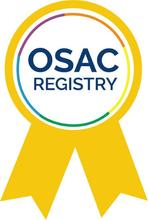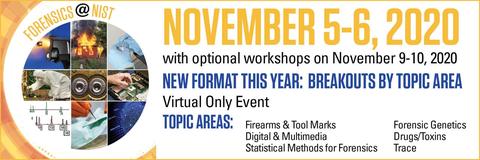November 2020
This Standards Bulletin from the Organization of Scientific Area Committees (OSAC) for Forensic Science provides an update on:
- Standards moving through the OSAC Registry approval process.
- Standards moving through the development process at standards developing organizations (SDOs).
New standards placed on the OSAC Registry: 3
SDO documents published: 2
SDO documents open for comment: 9
In this issue
OSAC Regsistry Updates

The OSAC Registry is a repository of high-quality, technically sound published and proposed standards for forensic science. These written documents define minimum requirements, best practices, standard protocols and other guidance to help ensure that the results of forensic analysis are reliable and reproducible.
New Documents on the OSAC Registry
- ASTM E3233-20 Standard Practice for Forensic Tape Analysis Training Program.
- ASTM E3234-20 Standard Practice for Forensic Paint Analysis Training Program.
- ANSI/NIST ITL-1:2011 (update 2015) Data Format for the Interchange of Fingerprint, Facial & Other Biometric Information.
Standards Under Consideration
Under Review by Scientific & Technical Review Panels (STRPs)
- 2020-S-001, Standard for Friction Ridge Examination Proficiency Testing Program.
- 2020-S-002, Physical Stability of Facial Features of Adults.
- 2020-S-003, Guideline for Performing Alcohol Calculations in Forensic Toxicology.
- 2020-S-004, Standard for Interpreting and Reporting DNA Test Results Associated with Failed Controls and Contamination Events.
At FSSB for Vote (OSAC Legacy Process for Registry Approval)
- ASTM E1388-17 Standard Practice for Static Headspace Sampling of Vapors from Fire Debris Samples.
- ASTM E1412-19 Standard Practice for Separation of Ignitable Liquid Residues from Fire Debris Samples by Passive Headspace Concentration with Activated Charcoal.
- ASTM E1413-19 Standard Practice for Separation of Ignitable Liquid Residues from Fire Debris Samples by Dynamic Headspace Concentration onto an Adsorbent Tube.
- ASTM E3189-19 Standard Practice for Separation of Ignitable Liquid Residues from Fire Debris Samples by Static Headspace Concentration onto an Adsorbent Tube.
Has your organization already started implementing OSAC Registry standards? Complete OSAC's Laboratory Implementation Declaration Form and send it to mark.stolorow [at] nist.gov (mark[dot]stolorow[at]nist[dot]gov) to let us know. Share your implementation experience and be featured in a future OSAC news post.
SDO Updates
Published
The following two documents have recently been published by an SDO:
AAFS Standards Board (ASB):
- ASB Technical Report 051, Scope of Work for a Footwear/Tire Examiner, First Edition, 2020. This document, initially drafted by OSAC’s Footwear & Tire Subcommittee and finalized by the ASB Footwear and Tire Consensus Body, covers the primary responsibilities, types of examinations, and constituent duties of a footwear/tire examiner for lab management, quality assurance, law enforcement and the judiciary.
ASTM:
- ASTM E1588-20 Standard Practice for Gunshot Residue Analysis by Scanning Electron Microscopy/Energy Dispersive X-Ray Spectrometry. Revised by OSAC’s Ignitable Liquids, Explosives, & Gunshot Residue Subcommittee (formerly OSAC’s Gunshot Residue Subcommittee), this document covers the analysis of gunshot residue (GSR) by scanning electron microscopy/energy-dispersive X-ray spectrometry (SEM/EDS). The analysis is performed using automated software control of both the SEM and EDS systems, to screen the sample for candidate particles that could be associated with GSR. Manual control of the instrument is then used to perform confirmatory analysis and classification of the candidate particles. This practice refers solely to the analysis of electron microscopy stubs.
Comment Period Open on Draft Documents
ASB:
- ASB Best Practice Recommendation 008, Mass Fatality Scene Processing: Best Practice Recommendations for the Medicolegal Authority. This document provides definitions, guidelines, and best practices for the detection, processing, and recovery of physical and contextual evidence associated with mass fatality disaster scenes to ensure that evidence is carefully and consistently documented and recovered in situ. This document focuses on terrestrial scenes that do not involve a significant hazardous materials component. Comment deadline November 16, 2020.
- ASB Standard 013, Standard for Friction Ridge Examination Conclusions. This standard defines terms and establishes qualitative expressions for the categories of conclusions that may be reached following friction ridge comparisons. Comment deadline November 16, 2020.
- Recirculation* – ASB Standard 134, Standard for Analyzing Pathological Conditions and Anomalies in Forensic Anthropology. This standard sets forth techniques and approaches for describing, documenting, interpreting, and reporting pathological conditions and anomalies from skeletal and dental material and/or radiographic images. Comment deadline November 16, 2020.
- ASB Standard 146, Standard for Resolving Commingled Remains in Forensic Anthropology. This document provides the procedures and requirements for resolving commingled remains. The techniques presented include size, age, and sex similarities, articulation between skeletal elements, taphonomic similarities, and reconstruction of fragmentary remains. The document also describes the determination of MNI (Minimum Number of Individuals), as well as the LI (Lincoln Index) and MLNI (Most Likely Number of Individuals) based on the number of paired and unpaired bones. Comment deadline November 16, 2020.
- Recirculation* – ASB Best Practice Recommendation 114, Best Practice Recommendations for Internal Validation of Software Used in Forensic DNA Laboratories. This best practice recommendation assists a laboratory in designing internal validation studies to evaluate the various software programs used in the forensic DNA laboratory. This guidance document applies to, but is not limited to the following: (a) software used as a component, part, or accessory of instrumentation; (b) software that impacts the chain of custody documentation; (c) software that impacts the decision process and/or influences conclusions or reporting; and (d) software created by the laboratory to assist with calculations and/or data transfers. Comment deadline November 26, 2020.
- Recirculation* – ASB Standard 027, Standard for Training and Certification of Canine Detection of Humans: Patrol Canine Team. This document provides standards for the training, certification, and documentation pertaining to canine teams (canine and handler) trained to search for specific person(s), location(s), and/or article(s) by starting from the last known position. This pertains to trails less than 24 hours old. Comment deadline November 30, 2020.
- ASB Standard 132, Standard for Population Affinity in Estimation in Forensic Anthropology. This standard provides procedures for the estimation of population affinity from skeletal material. Specific methods and techniques are not included. This standard is not applicable to subadult skeletal remains, when cranial and postcranial features are not fully developed. Comment deadline December 7, 2020.
- ASB Standard 127, Standard for the Preservation and Examination of Charred Documents. This document establishes the minimum required procedures used by Forensic Document Examiners (FDEs) in the preservation of, examination of, and reporting on charred documents. This generally includes the examination of charred documents for content (writing, printing), material (paper, cardboard, plastic etc.) and source determination. This does not include chemical examination of documents for accelerants or source of combustion. Comment deadline, December 14, 2020.
- ASB Standard 128, Standard for the Preservation and Examination of Liquid Soaked Documents. This document establishes the minimum required procedures used by FDEs in the preservation of, examination of, and reporting on liquid soaked documents. This generally includes the examination of documents exposed to liquids (water, blood, oils etc.) for content (writing, printing), material (paper, cardboard, plastic etc.), and source determination. This standard does not include the examination of documents for the identification of the liquid contaminate(s). Comment deadline, December 14, 2020.
*Comments on a re-circulation will only be accepted on revised sections of a document, comments made to text not revised from the original comment period will not be accepted.
For the ASB documents listed above, download the comment template and return it to asb [at] aafs.org (asb[at]aafs[dot]org) by the comment deadline.
Other News
FORENSICS@NIST2020

Join our NIST colleagues on November 5-6 for FORENSICS@NIST2020 and learn how advanced methods in metrology, computer science and statistics are being used to strengthen forensic science. Learn more here.
Upcoming Webinar: "Mock Juror Perceptions of Forensics"

The Center for Statistics and Applications in Forensic Evidence (CSAFE) invites researchers, collaborators, and members of the broader forensics and statistics communities to participate in the webinar, “Mock Juror Perceptions of Forensics”, on Tuesday, December 8 from 11:00 – 12:00 pm CST.
Get Involved with OSAC
OSAC offers a variety of ways for members, affiliates and other experts in the forensic science community to participate in the standards advancement process. Click here to learn how you can help make an impact on the forensic science community through standards.

